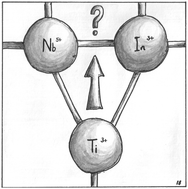Understanding the role of electrons in the magnetism of a colossal permittivity dielectric material†
Abstract
Creating new materials that show potential for technological devices is one of the most important and active areas of solid state chemistry and physics. For data storage, multiferroics present some great advantages due to the coupling of their electrical and magnetic properties. The discovery of In and Nb co-doped rutile (Hu et al. Nat. Mater. 12, 821) presented a material that was perfect for capacitive devices; with high permittivity and low loss, which was attributed to localised polarisable defects within the crystal structure, though other work has suggested internal blocking barriers at grain boundaries as being responsible for the dielectric properties. Here we report on the magnetic properties of this material and shown that magnetic ordering occurs at room temperature and below, with the Curie temperature depending upon doping levels. Moreover, muon spin relaxation measurements suggest that the magnetic order is confined to grain boundaries or areas where the defects can cluster. This implies that a strong magneto-electronic coupling could exist within In- and Nb-co-doped rutile close to room temperature, though the inhomogeneous nature of the magnetism suggests that the coupling may be optimised in nanoparticles or thin films where defect clustering could be promoted.



 Please wait while we load your content...
Please wait while we load your content...